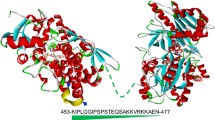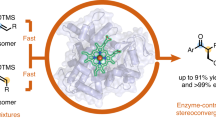Abstract
The enantioselective epoxidation of styrene and related compounds by two-component styrene monooxygenases (SMOs) has targeted these enzymes for development as biocatalysts. In the present work, we prepare genetically engineered fusion proteins that join the C-terminus of the epoxidase (StyA) to the N-terminus of the reductase (StyB) through a linker peptide and demonstrate their utility as biocatalysts in the synthesis of Tyrain purple and other indigoid dyes. A single-vector expression system offers a simplified platform for transformation and expansion of the catalytic function of styrene monooxygenases, and the resulting fusion proteins are self-regulated and couple efficiently NADH oxidation to styrene epoxidation. We find that the reductase domain proceeds through a sequential ternary-complex mechanism at low FAD concentration and a double-displacement mechanism at higher concentrations of FAD. Single-turnover studies indicate an observed rate constant for FAD-to-FAD hydride transfer of ~8 s−1. This step is rate limiting in the styrene epoxidation reaction and helps to ensure that flavin reduction and styrene epoxidation reactions proceed without wasteful side reactions. Comparison of the reductase activity of the fusion proteins with the naturally occurring reductase, SMOB, and N-terminally histidine-tagged reductase, NSMOB, suggests that the observed changes in catalytic mechanism are due in part to an increase in flavin-binding affinity associated with the N-terminal extension of the reductase.







Similar content being viewed by others
References
Higgins, L. J., Yan, F., Liu, P., Liu, H. W., & Drennan, C. L. (2005). Structural insight into antibiotic fosfomycin biosynthesis by a mononuclear iron enzyme. Nature, 437, 838–844.
Laden, B. P., Tang, Y., & Porter, T. D. (2000). Cloning, heterologous expression, and enzymological characterization of human squalene monooxygenase. Archives of Biochemistry and Biophysics., 374, 381–388.
Hieber, A. D., Bugos, R. C., & Yamamoto, H. Y. (2000). Plant lipocalins: violaxanthin de-epoxidase and zeaxanthin epoxidase. Biochimica et Biophysica Acta, 1482, 84–91.
Hartmans, S., van der Werf, M. J., & de Bont, J. A. (1990). Bacterial degradation of styrene involving a novel flavin adenine dinucleotide-dependent styrene monooxygenase. Applied and Environmental Microbiology, 56, 1347–1351.
Archelas, A., & Furstoss, R. (1997). Synthesis of enantiopure epoxides through biocatalytic approaches. Annual Review of Microbiology, 51, 491–525.
Choi, W. J. (2009). Biotechnological production of enantiopure epoxides by enzymatic kinetic resolution. Applied microbiology and biotechnology., 84, 239–247.
Lin, H., Liu, J. Y., Wang, H. B., Ahmed, A. A., & Wu, Z. L. (2011). Biocatalysis as an alternative for the production of chiral epoxides: a comparative review. Journal of Molecular Catalysis B: Enzymatic., 72, 77–89.
Fukami, T., Katoh, M., Yamazaki, H., Yokoi, T., & Nakajima, M. (2008). Human cytochrome P450 2A13 efficiently metabolizes chemicals in air pollutants: naphthalene, styrene, and toluene. Chemical Research in Toxicology, 21, 720–725.
Green, J., & Dalton, H. (1989). A stopped-flow kinetic study of soluble methane mono-oxygenase from Methylococcus capsulatus (Bath). The Biochemical Journal, 259, 167–172.
Thibodeaux, C. J., Chang, W. C., & Liu, H. W. (2012). Enzymatic chemistry of cyclopropane, epoxide, and aziridine biosynthesis. Chemical Reviews, 112, 1681–1709.
van Berkel, W. J., Kamerbeek, N. M., & Fraaije, M. W. (2006). Flavoprotein monooxygenases, a diverse class of oxidative biocatalysts. Journal of Biotechnology, 124, 670–689.
Huijbers, M. M., Montersino, S., Westphal, A. H., Tischler, D., & van Berkel, W. J. (2014). Flavin dependent monooxygenases. Archives of Biochemistry and Biophysics., 544C, 2–17.
Panke, S., Witholt, B., Schmid, A., & Wubbolts, M. G. (1998). Towards a biocatalyst for (S)-styrene oxide production: characterization of the styrene degradation pathway of Pseudomonas sp. strain VLB120. Applied and Environmental Microbiology, 64, 2032–2043.
Teufel, R., Mascaraque, V., Ismail, W., Voss, M., Perera, J., Eisenreich, W., Haehnel, W., & Fuchs, G. (2010). Bacterial phenylalanine and phenylacetate catabolic pathway revealed. Proceedings of the National Academy of Sciences of the United States of America, 107, 14390–14395.
Montersino, S., Tischler, D., Gassner, G. T., & van Berkel, W. J. (2011). Catalytic and structural features of flavoprotein hydroxylases and epoxidases. Advanced Synthesis and Catalysis, 353, 2301–2319.
Morrison, E., Kantz, A., Gassner, G. T., & Sazinsky, M. H. (2013). Structure and mechanism of styrene monooxygenase reductase: new insight into the FAD-transfer reaction. Biochemistry, 52, 6063–6075.
Ukaegbu, U. E., Kantz, A., Beaton, M., Gassner, G. T., & Rosenzweig, A. C. (2010). Structure and ligand binding properties of the epoxidase component of styrene monooxygenase. Biochemistry, 49, 1678–1688.
Kantz, A., & Gassner, G. T. (2011). Nature of the reaction intermediates in the flavin adenine dinucleotide-dependent epoxidation mechanism of styrene monooxygenase. Biochemistry, 50, 523–532.
Kantz, A., Chin, F., Nallamothu, N., Nguyen, T., & Gassner, G. T. (2005). Mechanism of flavin transfer and oxygen activation by the two-component flavoenzyme styrene monooxygenase. Archives of Biochemistry and Biophysics., 442, 102–116.
Bae, J. W., Doo, E. H., Shin, S. H., Lee, S. G., Jeong, Y. J., Park, J. B., & Park, S. (2010). Development of a recombinant Escherichia coli-based biocatalyst to enable high styrene epoxidation activity with high product yield on energy source. Process Biochemistry., 45, 147–152.
Tischler, D., Eulberg, D., Lakner, S., Kaschabek, S. R., van Berkel, W. J., & Schlomann, M. (2009). Identification of a novel self-sufficient styrene monooxygenase from Rhodococcus opacus 1CP. Journal of Bacteriology, 191, 4996–5009.
Tischler, D., Kermer, R., Groning, J. A., Kaschabek, S. R., van Berkel, W. J., & Schlomann, M. (2010). StyA1 and StyA2B from Rhodococcus opacus 1CP: a multifunctional styrene monooxygenase system. Journal of Bacteriology, 192, 5220–5227.
Tischler, D., Schlomann, M., van Berkel, W. J., & Gassner, G. T. (2013). FAD C(4a)-hydroxide stabilized in a naturally fused styrene monooxygenase. FEBS letters., 587, 3848–3852.
Tischler, D., Groning, J. A., Kaschabek, S. R., & Schlomann, M. (2012). One-component styrene monooxygenases: an evolutionary view on a rare class of flavoproteins. Applied Biochemistry and Biotechnology, 167, 931–944.
Munro, A. W., Leys, D. G., McLean, K. J., Marshall, K. R., Ost, T. W., Daff, S., Miles, C. S., Chapman, S. K., Lysek, D. A., Moser, C. C., Page, C. C., & Dutton, P. L. (2002). P450 BM3: the very model of a modern flavocytochrome. Trends in Biochemical Sciences, 27, 250–257.
Jawanda, N., Ahmed, K., & Tu, S. C. (2008). Vibrio harveyi flavin reductase–luciferase fusion protein mimics a single-component bifunctional monooxygenase. Biochemistry, 47, 368–377.
Sambrook, J., & Russell, D. W. (2001). Molecular cloning; a laboratory manual (3rd ed.). Cold Spring Harbor, NY: Cold Spring Harbor Laboratory Press.
Oelschlagel, M., Groning, J. A., Tischler, D., Kaschabek, S. R., & Schlomann, M. (2012). Styrene oxide isomerase of Rhodococcus opacus 1CP, a highly stable and considerably active enzyme. Applied and Environmental Microbiology, 78, 4330–4337.
O’Connor, K. E., & Hartmans, S. (1998). Indigo formation by aromatic hydrocarbon-degrading bacteria. Biotechnology Letters., 20, 219–233.
Gasteiger E., Hoogland C., Gattiker A., Duvaud S., Wilkins M. R., Appel R. D. et al. (2005). Protein identification and analysis tools on the ExPASy server. In J. M. Walker (Ed.), The Proteomics Protocols Handbook (pp. 571–607). Humana Press.
Chen, R. F. (1967). Removal of fatty acids from serum albumin by charcoal treatment. The Journal of Biological Chemistry, 242, 173–181.
Motulsky, H. J., & Christopoulos, A. (2003). Fitting models to biological data using linear and nonlinear regression. San Diego: GraphPad Software Inc..
Choi, H. S., Kim, J. K., Cho, E. H., Kim, Y. C., Kim, J. I., & Kim, S. W. (2003). A novel flavin-containing monooxygenase from Methylophaga sp strain SK1 and its indigo synthesis in Escherichia coli. Biochemical and biophysical research communications., 306, 930–936.
Otto, K., Hofstetter, K., Rothlisberger, M., Witholt, B., & Schmid, A. (2004). Biochemical characterization of StyAB from Pseudomonas sp. strain VLB120 as a two-component flavin-diffusible monooxygenase. Journal of Bacteriology, 186, 5292–5302.
Qaed, A. A., Lin, H., Tang, D. F., & Wu, Z. L. (2011). Rational design of styrene monooxygenase mutants with altered substrate preference. Biotechnology Letters, 33, 611–616.
Lin, H., Qiao, J., Liu, Y., & Wu, Z. L. (2010). Styrene monooxygenase from Pseudomonas sp. LQ26 catalyzes the asymmetric epoxidation of both conjugated and unconjugated alkenes. Journal of Molecular Catalysis B: Enzymatic., 67, 236–241.
Lin, H., Liu, Y., & Wu, Z. L. (2011). Highly diastereo- and enantio-selective epoxidation of secondary allylic alcohols catalyzed by styrene monooxygenase. Chemical Communications (Cambridge, England), 47, 2610–2612.
Lin, H., Tang, D. F., Ahmed, A. A., Liu, Y., & Wu, Z. L. (2012). Mutations at the putative active cavity of styrene monooxygenase: enhanced activity and reversed enantioselectivity. Journal of Biotechnology, 161, 235–241.
De Mot, R., & Parret, A. H. (2002). A novel class of self-sufficient cytochrome P450 monooxygenases in prokaryotes. Trends in Microbiology, 10, 502–508.
Kapadia, G. J., Tokuda, H., Sridhar, R., Balasubramanian, V., Takayasu, J., Bu, P., Enjo, F., Takasaki, M., Konoshima, T., & Nishino, H. (1998). Cancer chemopreventive activity of synthetic colorants used in foods, pharmaceuticals and cosmetic preparations. Cancer Letters, 129, 87–95.
Hössel, R. (1999a). Synthese von Derivaten des Indirubins und Untersuchungen zur Mechanismsaufklärung ihrer antineoplastischen Wirkung. Kaiserslautern: Universität Kaiserslautern.
Guengerich, F. P., Sorrells, J. L., Schmitt, S., Krauser, J. A., Aryal, P., & Meijer, L. (2004). Generation of new protein kinase inhibitors utilizing cytochrome p450 mutant enzymes for indigoid synthesis. Journal of Medicinal Chemistry, 47, 3236–3241.
Guengerich, P. F., Martin, M. V., McCormick, W. A., Nguyenb, L. P., Glover, E., & Bradfield, C. A. (2004). Aryl hydrocarbon receptor response to indigoids in vitro and in vivo. Archives of Biochemistry and Biophysics., 423, 309–316.
Wu, Z. L., Aryal, P., Lozach, O., Meijer, L., & Guengerich, F. P. (2005). Biosynthesis of new indigoid inhibitors of protein kinases using recombinant cytochrome P450 2A6. Chemistry & Biodiversity, 2, 51–65.
Harrer, R. (2012). Indigo auf Speicherchips. Chemie in userer Zeit, 46, 136.
Uehara, K., Takagishi, K., & Tanaka, M. (1987). The Al/Indigo/Au photovoltaic cell. Solar Cells., 22, 295–301.
Lüttke, W., & Hunsdiecker, D. (1966). Theoretische und spetroskopische Untersuchungen an Indigofarbstoffen, IV. Substituenteneffekt am Indigo: Die Darstellung des 5.5′-und 6.6′-Diaza-indigos. Chemische Berichte, 99, 2146–2154.
Gursky, L. J., Nikodinovic-Runic, J., Feenstra, K. A., & O’Connor, K. E. (2010). In vitro evolution of styrene monooxygenase from Pseudomonas putida CA-3 for improved epoxide synthesis. Applied microbiology and biotechnology., 85, 995–1004.
Nikodinovic-Runic, J., Coulombel, L., Francuski, D., Sharma, N. D., Boyd, D. R., Ferrall, R. M., & O’Connor, K. E. (2013). The oxidation of alkylaryl sulfides and benzo[b]thiophenes by Escherichia coli cells expressing wild-type and engineered styrene monooxygenase from Pseudomonas putida CA-3. Applied microbiology and biotechnology., 97, 4849–4858.
Baggi, G., Boga, M. M., Catelani, D., Galli, E., & Treccani, V. (1983). Styrene catabolism by a strain of Pseudomonas fluorescens. Systematic and Applied Microbiology, 4, 141–147.
Wehmeier Personal Communication.
Acknowledgments
This work was supported by NIHSC1 GM081140 to George Gassner and Dirk Tischler was supported by a Fulbright Scholarship. Nonye Okonkwo and Berhanegebriel Assefa were supported by the NIH-MARC program at SFSU.
Author information
Authors and Affiliations
Corresponding authors
Rights and permissions
About this article
Cite this article
Heine, T., Tucker, K., Okonkwo, N. et al. Engineering Styrene Monooxygenase for Biocatalysis: Reductase-Epoxidase Fusion Proteins. Appl Biochem Biotechnol 181, 1590–1610 (2017). https://doi.org/10.1007/s12010-016-2304-4
Received:
Accepted:
Published:
Issue Date:
DOI: https://doi.org/10.1007/s12010-016-2304-4




